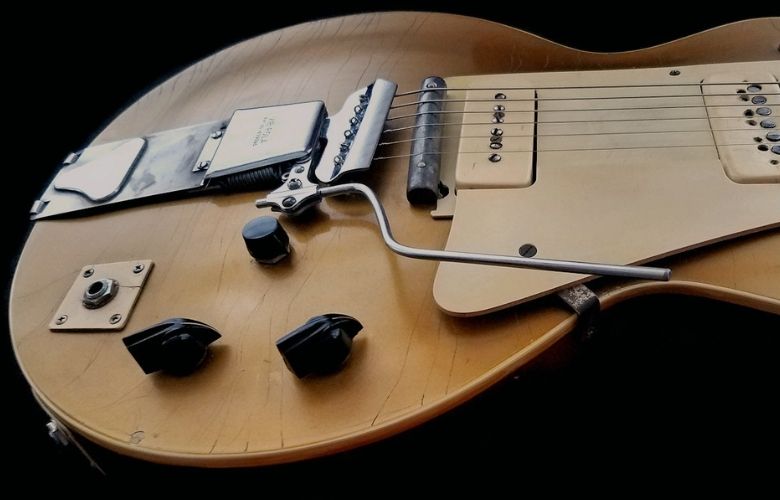
The first model of the iconic Gibson Les Paul guitar is going to be auctioned at Christie’s in New York City this October. The historic instrument was Les Paul’s personal original guitar, and undoubtedly pioneered his creation techniques, as well as heavily influencing the history of the instrument – and music as we know it in the years that followed.
The Goldtop Number One guitar is dated from 1952, and was borne from a creation pioneered by Les Paul himself, working in collaboration with the Gibson Guitar Company. This guitar edition was debuted on television in 1953, and is notable for a number of reasons, particularly when thinking of pop music in the pre-1955 era.
Dubbed as ‘the guitar that started it all’, the Les Paul website paints a picture of an eccentric scientist channelling a vision of an instrument into reality, pioneering the amplification techniques and mapping the structuring of this brand new instrument.
Les Paul was working to incorporate electric pickups into the instrument, and knew that he would have to make a rigid, solid bodied guitar with less hollowness in both the body and the neck than an acoustic guitar. The story explains:
“So he grabbed a piece of steel railroad track, fashioned two high points (a nut and a bridge), and ran a taught string across it. Then he mashed a telephone receiver under the string… and Eureka… it worked! The sound rang out… an amplified signal actually came out of his mother’s old time radio, and it had real sustain and tone!
Skipping ahead – Knowing that a big heavy piece of steel was simply not practical; Les had the idea of creating a “one-piece” solid wooden neck and body combination. So he went straight to work on the odd and somewhat disagreeable looking contraption that has been come to be known as “The Log”, a 4”x4” post with a guitar neck glued onto it.
Les was convinced that his idea was going to revolutionize the way guitars where made, played, how they sounded, and how the guitar and the guitarist would be perceived. So somewhere around the mid-1940’s Les proudly presented his new-fangled invention to the Gibson Guitar Corporation. They summarily passed on the idea, and quickly ushered “this crazy guy” out of their offices.”
Allegedly, when the success of Leo Fender’s “Spanish Electric Guitar” was apparent in the late 40s and early 50s, as well as the competition posed by the Fender Telecaster, Gibson requested the “crazy guy” come back for a meeting once again. Eventually, the collaboration bore prototypes, negotiations, experimentation, and the Les Paul Gold Top was born.
Les Paul’s son Gene Paul along with guitar-builder and musician Tom Doyle are responsible for auctioning off the 1952 Goldtop. Gene explains:
“My father spent a lifetime chasing his dream. It took almost three decades from his first experiments to finally receiving this Gibson Les Paul Goldtop in 1952. To Les, getting this guitar officially made by Gibson was his crowning achievement. This is the one that started it all for dad… and is probably the most historically significant, iconic, valuable, and culturally important guitar that the world has ever seen. In my opinion, this instrument belongs in the Smithsonian next to Neil Armstrong’s boot from the Moon landing. It is a national treasure.”
The guitar will be auctioned as part of The Exceptional Sale series at Christie’s New York on 13th October 2021.
Some of the most well-known Gibson Les Paul players include:
Eric Clapton, John Mayall and the Blues Breakers, Jeff Beck, Peter Green, Keith Richards, Freddie King, Mike Bloomfield, Jimmy Page, Billy Gibbons, Duane Allman, Gary Moore, Peter Framton, Paul Kosoff, Pete Townsend, Bernie Marsden, Randy Rhoads, Alex Lifeson, Joe Perry, Bob Marley, Neil Young, Joe Walsh, Tom Scholz, Dickey Betts, Ace Frehley, Joe Bonamassa, and Slash.
Adrian Angelico: A Virtuoso Trans Male Opera Singer
James “Fitz” FitzSimmons Interview: The Boys In The Band On Netflix


Michelle is a musician and composer from the UK. She has performed across the UK and Europe and is passionate about arts education and opportunities for women and girls.
Read Full Profile© 2021 TheatreArtLife. All rights reserved.

Thank you so much for reading, but you have now reached your free article limit for this month.
Our contributors are currently writing more articles for you to enjoy.
To keep reading, all you have to do is become a subscriber and then you can read unlimited articles anytime.
Your investment will help us continue to ignite connections across the globe in live entertainment and build this community for industry professionals.